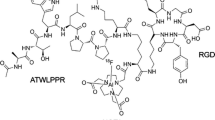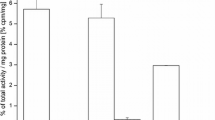Abstract
Purpose
We and others have reported that 18F- and 64Cu-labeled arginine–glycine–aspartate (RGD) peptides allow positron emission tomography (PET) quantification of integrin αvβ3 expression in vivo. However, clinical translation of these radiotracers is partially hindered by the necessity of cyclotron facility to produce the PET isotopes. Generator-based PET isotope 68Ga, with a half-life of 68 min and 89% positron emission, deserves special attention because of its independence of an onsite cyclotron. The goal of this study was to investigate the feasibility of 68Ga-labeled RGD peptides for tumor imaging.
Methods
Three cyclic RGD peptides, c(RGDyK) (RGD1), E[c(RGDyK)]2 (RGD2), and E{E[c(RGDyK)]2}2 (RGD4), were conjugated with macrocyclic chelator 1,4,7-triazacyclononane-1,4,7-triacetic acid (NOTA) and labeled with 68Ga. Integrin affinity and specificity of the peptide conjugates were assessed by cell-based receptor binding assay, and the tumor targeting efficacy of 68Ga-labeled RGD peptides was evaluated in a subcutaneous U87MG glioblastoma xenograft model.
Results
U87MG cell-based receptor binding assay using 125I-echistatin as radioligand showed that integrin affinity followed the order of NOTA–RGD4 > NOTA–RGD2 > NOTA–RGD1. All three NOTA conjugates allowed nearly quantitative 68Ga-labeling within 10 min (12–17 MBq/nmol). Quantitative microPET imaging studies showed that 68Ga-NOTA–RGD4 had the highest tumor uptake but also prominent activity accumulation in the kidneys. 68Ga-NOTA–RGD2 had higher tumor uptake (e.g., 2.8 ± 0.1%ID/g at 1 h postinjection) and similar pharmacokinetics (4.4 ± 0.4 tumor/muscle ratio, 2.0 ± 0.1 tumor/liver ratio, and 1.1 ± 0.1 tumor/kidney ratio) compared with 68Ga-NOTA–RGD1.
Conclusions
The dimeric RGD peptide tracer 68Ga-NOTA–RGD2 with good tumor uptake and favorable pharmacokinetics warrants further investigation for potential clinical translation to image integrin αvβ3.





Similar content being viewed by others
References
Albelda SM, Mette SA, Elder DE, Stewart R, Damjanovich L, Herlyn M, et al. Integrin distribution in malignant melanoma: association of the β3 subunit with tumor progression. Cancer Res. 1990;50:6757–64.
Bello L, Francolini M, Marthyn P, Zhang J, Carroll RS, Nikas DC, et al. αvβ3 and αvβ5 integrin expression in glioma periphery. Neurosurgery. 2001;49:380–9. discussion 90.
Brooks PC, Stromblad S, Klemke R, Visscher D, Sarkar FH, Cheresh DA. Antiintegrin αvβ3 blocks human breast cancer growth and angiogenesis in human skin. J Clin Invest. 1995;96:1815–22.
Puduvalli VK. Inhibition of angiogenesis as a therapeutic strategy against brain tumors. Cancer Treat Res. 2004;117:307–36.
Sengupta S, Chattopadhyay N, Mitra A, Ray S, Dasgupta S, Chatterjee A. Role of αvβ3 integrin receptors in breast tumor. J Exp Clin Cancer Res. 2001;20:585–90.
Hynes RO. Integrins: versatility, modulation, and signaling in cell adhesion. Cell. 1992;69:11–25.
Brooks PC, Clark RA, Cheresh DA. Requirement of vascular integrin αvβ3 for angiogenesis. Science. 1994;264:569–71.
Friedlander M, Brooks PC, Shaffer RW, Kincaid CM, Varner JA, Cheresh DA. Definition of two angiogenic pathways by distinct αv integrins. Science. 1995;270:1500–2.
Horton MA. The αvβ3 integrin “vitronectin receptor”. Int J Biochem Cell Biol. 1997;29:721–5.
Jin H, Varner J. Integrins: roles in cancer development and as treatment targets. Br J Cancer. 2004;90:561–5.
Kumar CC. Integrin αvβ3 as a therapeutic target for blocking tumor-induced angiogenesis. Curr Drug Targets. 2003;4:123–31.
Jung KH, Lee KH, Paik JY, Ko BH, Bae JS, Lee BC, et al. Favorable biokinetic and tumor-targeting properties of 99mTc-labeled glucosamino RGD and effect of paclitaxel therapy. J Nucl Med. 2006;47:2000–7.
Zhang X, Xiong Z, Wu Y, Cai W, Tseng JR, Gambhir SS, et al. Quantitative PET imaging of tumor integrin αvβ3 expression with 18F-FRGD2. J Nucl Med. 2006;47:113–21.
Tucker GC. αv integrin inhibitors and cancer therapy. Curr Opin Investig Drugs. 2003;4:722–31.
Dijkgraaf I, Liu S, Kruijtzer JA, Soede AC, Oyen WJ, Liskamp RM, et al. Effects of linker variation on the in vitro and in vivo characteristics of an 111In-labeled RGD peptide. Nucl Med Biol. 2007;34:29–35.
Dijkgraaf I, Kruijtzer JA, Liu S, Soede AC, Oyen WJ, Corstens FH, et al. Improved targeting of the αvβ3 integrin by multimerisation of RGD peptides. Eur J Nucl Med Mol Imaging. 2007;34:267–73.
Beer AJ, Haubner R, Goebel M, Luderschmidt S, Spilker ME, Wester HJ, et al. Biodistribution and pharmacokinetics of the. αvβ3-selective tracer 18F-galacto-RGD in cancer patients. J Nucl Med. 2005;46:1333–41.
Liu S. Radiolabeled multimeric cyclic RGD peptides as integrin αvβ3 targeted radiotracers for tumor imaging. Mol Pharm. 2006;3:472–87.
Liu S, Edwards DS, Ziegler MC, Harris AR, Hemingway SJ, Barrett JA. 99mTc-labeling of a hydrazinonicotinamide-conjugated vitronectin receptor antagonist useful for imaging tumors. Bioconjug Chem. 2001;12:624–9.
Sharma SD, Jiang J, Hadley ME, Bentley DL, Hruby VJ. Melanotropic peptide-conjugated beads for microscopic visualization and characterization of melanoma melanotropin receptors. Proc Natl Acad Sci USA. 1996;93:13715–20.
Mammen M, Chio S-K, Whitesides GM. Polyvalent interactions in biological systems: implications for design and use of multivalent ligands and inhibitors. Angew Chem Int Ed Engl. 1998;37:2755–94.
Wu Y, Zhang X, Xiong Z, Cheng Z, Fisher DR, Liu S, et al. microPET imaging of glioma integrin αvβ3 expression using 64Cu-labeled tetrameric RGD peptide. J Nucl Med. 2005;46:1707–18.
Ye Y, Bloch S, Xu B, Achilefu S. Design, synthesis, and evaluation of near infrared fluorescent multimeric RGD peptides for targeting tumors. J Med Chem. 2006;49:2268–75.
Wu Z, Li Z, Cai W, He L, Chin F, Li F, et al. 18F-labeled mini-PEG spacered RGD dimer (18F-FPRGD2): synthesis and microPET imaging of αvβ3 integrin expression. Eur J Nucl Med Mol Imaging. 2007;34:1823–31.
Wu Z, Li ZB, Chen K, Cai W, He L, Chin FT, et al. microPET of Tumor Integrin αvβ3 Expression Using 18F-Labeled PEGylated Tetrameric RGD Peptide (18F-FPRGD4). J Nucl Med. 2007;48:1536–44.
Li ZB, Cai W, Cao Q, Chen K, Wu Z, He L, et al. 64Cu-labeled tetrameric and octameric RGD peptides for small-animal PET of tumor αvβ3 integrin expression. J Nucl Med. 2007;48:1162–71.
Maecke HR, Hofmann M, Haberkorn U. 68Ga-labeled peptides in tumor imaging. J Nucl Med. 2005;46(Suppl 1):172S–8S.
Reubi JC, Schar JC, Waser B, Wenger S, Heppeler A, Schmitt JS, et al. Affinity profiles for human somatostatin receptor subtypes SST1-SST5 of somatostatin radiotracers selected for scintigraphic and radiotherapeutic use. Eur J Nucl Med. 2000;27:273–82.
Haubner R, Wester HJ, Burkhart F, Senekowitsch-Schmidtke R, Weber W, Goodman SL, et al. Glycosylated RGD-containing peptides: tracer for tumor targeting and angiogenesis imaging with improved biokinetics. J Nucl Med. 2001;42:326–36.
Benedetti E, Morelli G, Accardo A, Mansi R, Tesauro D, Aloj L. Criteria for the design and biological characterization of radiolabeled peptide-based pharmaceuticals. BioDrugs. 2004;18:279–95.
Clarke ET, Martell AE. Stabilities of trivalent metal ion complexes of tetraacetate derivatives of 12-, 13- and 14-membered tetraazamacrocycles. Inorganica Chim Acta. 1991;190:37–46.
Clarke ET, Martell AE. Stabilities of the Fe(III), Ga(III), and In(III) chelates of N,N′,N′-triazacyclononanetriacetic acid. Inorganica Chim Acta. 1991;181:273–80.
Acknowledgements
This work was supported in part by the National Cancer Institute (NCI) (R01 CA119053, R21 CA121842, R21 CA102123, P50 CA114747, U54 CA119367, and R24 CA93862) and the Department of Defense (DOD) (W81XWH-07-1-0374, W81XWH-04-1-0697, W81XWH-06-1-0665, W81XWH-06-1-0042, and DAMD17-03-1-0143). We thank Dr. Hui Wang for her help with tail vein injection and biodistribution experiment.
Author information
Authors and Affiliations
Corresponding author
Rights and permissions
About this article
Cite this article
Li, ZB., Chen, K. & Chen, X. 68Ga-labeled multimeric RGD peptides for microPET imaging of integrin αvβ3 expression. Eur J Nucl Med Mol Imaging 35, 1100–1108 (2008). https://doi.org/10.1007/s00259-007-0692-y
Received:
Accepted:
Published:
Issue Date:
DOI: https://doi.org/10.1007/s00259-007-0692-y




